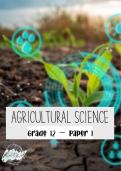Samenvatting
Summary Grade 12_Agricultural Sciences [Paper 1] Summaries
- Vak
- Instelling
Introducing our Grade 12 Agricultural Sciences [Paper 1] Notes - the ultimate study companion for students undertaking paper one of their Agricultural Sciences exam. This comprehensive notebook covers essential topics such as animal feed, reproduction and parasite control, all presented in a colorf...
[Meer zien]




